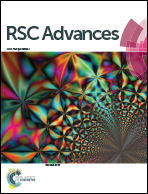The effect of copper species in copper-ceria catalysts: structure evolution and enhanced performance in CO oxidation†
Abstract
In this paper, copper doped ceria porous nanospheres were synthesized using carbon nanospheres as a hard template via a homogenous precipitation method at low temperature. The results showed that the copper-doped ceria has undergone a morphology transformation from the initial double-shell spheres to hollow spheres as the copper doping concentration increased from 0 to 7.5%mol. Notably, the Cu/Ce + Cu atomic ratio in the final products was approximately five times the initial design ratio, which confirmed an efficient utilization of copper in this system. Furthermore, the copper-ceria catalysts exhibited enhanced catalytic performance towards CO conversion when compared with pure ceria catalysts (e.g., for the optimal catalysts, the complete conversion temperature was 160 °C, for the pure catalysts, complete conversion temperature was 300 °C). Through the analysis of the catalysts structure, we proved that the superior catalytic performance was derived from a combination of CuOx clusters and copper ions in the Cu–[Ox]–Ce bulk phase.


 Please wait while we load your content...
Please wait while we load your content...